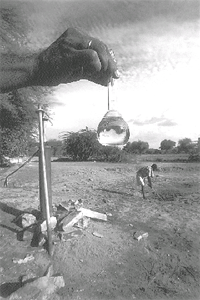Reviving Saraswati
 the Rajasthan Groundwater Department ( rgwd ) has embarked on an ambitious project, which if successfully implemented, could solve the water problems of the state. The board is trying to revive ancient water channels that are lying buried 60 metres under the ground. There are indications that these channels were formed by the river Saraswati, that is mentioned in the Rig Veda and as well as in the Mahabharata .
the Rajasthan Groundwater Department ( rgwd ) has embarked on an ambitious project, which if successfully implemented, could solve the water problems of the state. The board is trying to revive ancient water channels that are lying buried 60 metres under the ground. There are indications that these channels were formed by the river Saraswati, that is mentioned in the Rig Veda and as well as in the Mahabharata .
These paleo-channels, if revived, can solve the state's water crisis, by making way for the precious resource to flow from Punjab. Even, monsoon water can be stored for future use. If the project fulfils its aims, Rajasthan will become the first place in the world to use paleo-channels for transporting and storing water.
Contrary to popular belief, the Saraswati is not a myth, say experts. The channels indicate that it was 1,500 km three to 15 km wide and flowed through present day Himachal Pradesh, Haryana, Punjab and Rajasthan.
Scientists got a inkling of the presence of the Saraswati two decades ago, when satellite photographs showed presence of underground water around Jaisalmer and its flow had a definite pattern. When they tallied scientific data with the ancient literature, they were convinced about the existence of Saraswati. However, scientists insist that it is too early to call the project "revival of the Saraswati river.' Officially, the project is known as "revival of paleo-channels.'
Images supplied by the Indian Space Research Organisation ( isro ) and the Geological Survey of India ( gsi ) confirmed the existence of paleo-channels in seven or eight areas west of the Aravallis. When these images were examined, a definite river pattern could be identified. The river, it seems, originated from the foothills of Aravallis and then shifted westwards in the later stages.
"It is a cooperative exercise between history and science', says K K Srivastava, the divisional chief of the rgwd 's research, design and development division. The project received a grant of Rs 4.7 million from the Rajiv Gandhi National Mission for Drinking Water. The project is being assisted by the Central Groundwater Board, isro , Bhabha Atomic Research Centre ( barc ) and the National Physical Laboratory ( npl ).
Initial evidence of the presence of these paleo-channels surfaced in the 1930s when scientists Haren and B C Gupta of the Zoological Survey of India claimed that the channels were probably the original course of the river. Similarly, after studying the topography of the region, Bimal Ghose, a former scientist at the Central Arid Zone Research Institute ( cazri) , Jodhpur, confirmed that the ancient channels belonged to a dead river, possibly the Saraswati.
According to scientists at the rgwd , desertification of western Rajasthan started only 5,000-6,000 years ago. Due to marine tectonic activity, seawater submerged the area between Rann of Kutch and Bikaner. As the water remained static for a few hundreds years, the desertification process started.
It is believed, that Saraswati was buried by sandstorms and due to tectonic movement in the Himalayas, its source, it got delinked. Consequently, it dried up. Some believe that the Yamuna intruded on the course of the Saraswati diverting its waters. This may have led to the drying up of the river.
In the early 1980s, the state ground water scientists detected saline water near freshwater tanks in the Jaisalmer district. "It gave us an indication that there must be some source of fresh water', recalls K K Srivastava. After an extensive survey, water channels were discovered 60-70 metres below the ground. There are paleo-channels in all the 10 districts of western Rajasthan which have been mapped to chart the river's ancient course. Though the course of the river is yet to be traced completely, it is believed that like other major rivers, the Saraswati also changed its course frequently. This, some believe, is the reason behind the multiple channels buried underground.
